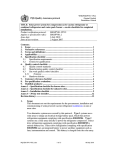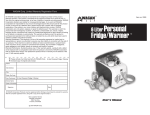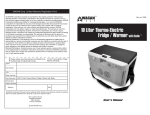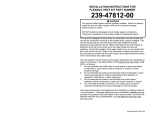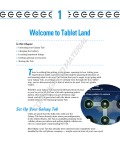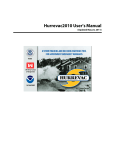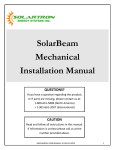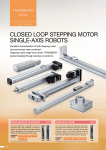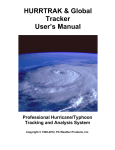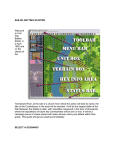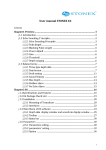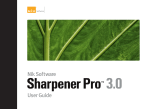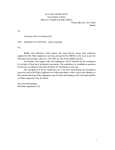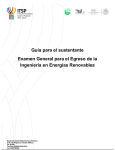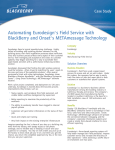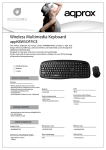Download PQS E03 PV1.2.doc - World Health Organization
Transcript
PQS performance specification WHO/PQS/E003/PV01.2 Original: English Distribution: General TITLE: Solar power system for compression-cycle vaccine refrigerator or combined refrigerator and water-pack freezer. Specification reference: E003/PV01.2 Product verification protocol: E003/PV01-VP.2 Issue date: 6 July 2010 Date of last revision: 2 August 2007 Contents: 1. Scope: ............................................................................................................... 2 2. Normative references: ..................................................................................... 2 3. Terms and definitions:..................................................................................... 3 4. Requirements:.................................................................................................. 4 4.1 General: ..................................................................................................... 4 4.1.1 System characteristics:....................................................................... 4 4.1.2 Design responsibility:......................................................................... 4 4.2 Performance:.............................................................................................. 5 4.2.1 Photovoltaic array: ............................................................................ 5 4.2.2 Array support structure:..................................................................... 5 4.2.3 Battery set sizing:............................................................................... 6 4.2.4 Battery type:....................................................................................... 6 4.2.5 Battery set housing:............................................................................ 6 4.2.6 Battery charge regulator: ................................................................... 6 4.2.7 Battery safety kit: ............................................................................... 7 4.2.8 Power switch:..................................................................................... 7 4.2.9 Electrical safety rating:...................................................................... 7 4.2.10 Electrical protection: ......................................................................... 7 4.2.11 Lightning surge protection: ................................................................ 7 4.3 Environmental requirements: ..................................................................... 7 4.3.1 Ambient temperature range during transport and storage: ................. 7 4.3.2 Ambient temperature range during use:.............................................. 7 4.3.3 Ambient humidity range during transport and storage: ...................... 7 4.3.4 Resistance to storm damage: .............................................................. 8 4.4 Physical characteristics: ............................................................................. 8 4.4.1 Overall dimensions: ........................................................................... 8 4.4.2 Weight: .............................................................................................. 8 4.5 Interface requirements:............................................................................... 8 4.5.1 Refrigerator(s): .................................................................................. 8 4.6 Human factors:........................................................................................... 8 4.6.1 Generally: .......................................................................................... 8 4.6.2 Safe access:........................................................................................ 8 4.7 Materials:................................................................................................... 8 4.7.1 Restricted materials............................................................................ 8 4.8 Warranty:................................................................................................... 9 4.9 Servicing provision: ................................................................................... 9 4.9.1 Maintainability: ................................................................................. 9 4.9.2 Essential spare parts:......................................................................... 9 PQS E03 PV1.2.doc 1 of 13 06 July 2010 4.10 Disposal and recycling: .............................................................................10 4.11 Instructions: ..............................................................................................10 4.12 Training: ...................................................................................................10 4.13 Verification:..............................................................................................10 5. Packaging:.......................................................................................................10 6. On-site installation: ........................................................................................10 7. Product dossier: ..............................................................................................11 8. On-site maintenance:......................................................................................11 9. Change notification: .......................................................................................11 10. Defect reporting:.............................................................................................12 1. Scope: This specification describes the requirements for solar power systems that operate compression-cycle vaccine refrigerators or combined refrigerator and water-pack freezers. Qualified suppliers are also free to offer the installation and maintenance services described in this document, although the provision of these services is not a condition for pre-qualification. On-going supply of spare parts is a mandatory requirement. Two alternative systems are covered by this protocol. Type 1 systems use a solar array to charge an electrical storage battery pack, which then powers refrigeration equipment complying with specification E003/RF04. Type 2 systems use a solar array directly to power the refrigerator compressor. Direct drive refrigeration equipment complying with specification E003/RF05 is entirely battery free. Direct drive refrigeration complying with specification E003/RF06 uses an integrated battery to power ancillary equipment such as fans, instrumentation and control. This battery is charged from the solar array. The following verification documents are associated with this specification: • E003/PV01-VP1.2 is a type-examination protocol which will be used for pre-qualification evaluations. • E003/PV01-VP2.2 is a quality assurance protocol which specifies the installation, commissioning and handover procedure for a complete Type 1 or Type 2 system. It is intended to be used as an on-site checklist by the person responsible for signing off the completed installation on behalf of the procurement agency. 2. Normative references: EMAS: European Union Eco-Management and Audit Scheme. IEC 60335-1: 2006: Household and similar electrical appliances - Safety Part 1: General requirements. IEC 60364-1: 2005 Low-voltage electrical installations - Part 1: Fundamental principles, assessment of general characteristics, definitions. IEC 61194: 1992: Characteristic parameters of stand-alone photovoltaic (PV) systems. IEC 61215: 2005: Crystalline silicon terrestrial photovoltaic (PV) modules Design qualification and type approval. IEC 61646: 2008: Thin film terrestrial photovoltaic (PV) modules - Design qualification and type approval. PQS E03 PV1.2.doc 2 of 13 06 July 2010 ISO 1461: 2009: Hot dip galvanized coatings on iron and steel articles specifications and test methods. ISO 9001: Quality Management Systems – Requirements. ISO 14001: 2004: Environmental management systems - Requirements with guidance for use. ISO 20282-1: 2006: Ease of operation of everyday products - Part 1: Context of use and user characteristics. Solar Autonomy Calculation Tool, H.Toma and T. Markvart, University of Southampton, UK 2009. 3. Terms and definitions: Note: Solar energy definitions are contained in IEC 61194. Autonomy: Time in days that a solar refrigerator, or combined refrigerator and water-pack freezer, can maintain the vaccine load within the acceptable temperature range under low solar radiation conditions (e.g. rain). Autonomy is determined as described in clause 4.1.2 and measured as described in E003/RF05-VP.2 and E003/RF06-VP.1. In writing: means communication by letter, fax or email. Installation: The solar power system components specified in this document connected to a refrigerator, or combined refrigerator and water-pack freezer, complying with specification E003/RF04, E003/RF05 or E003/RF06. Installation technician: The person who installs the solar power system and associated refrigerator on behalf of the procurement agency. Legal Manufacturer: The natural or legal person with responsibility for the design, manufacture, packaging and labelling of a product or device before it is placed on the market under his own name, regardless of whether these operations are carried out by that person himself or on his behalf by a third party. Montreal Protocol: Montreal Protocol on Substances that Deplete the Ozone Layer. Procurement Agency: The organization which purchases the equipment covered by this specification and which provides the qualified supplier with details of the installation site(s). Qualified Supplier: A qualified supplier may be either a legal manufacturer or a reseller and must: • Supply a coherent, correctly sized installation where the settings of all the components have been adjusted for optimum performance at the installation site. • Have installed and supported (e.g. by providing on-going technical assistance, spare parts and system documents) at least 50 photovoltaic systems in a developing country or countries for at least two years (detailed references, including donors, locations and contacts, must be provided for independent verification). • Have the capacity and financial resources to provide long-term support to the systems in the country of destination. • Offer one or more refrigerators or combined refrigerator and water-pack freezers complying with PQS standards E003/RF04 and/or E003/RF05 and/or E003/RF06 and which are currently pre-qualified by WHO. PQS E03 PV1.2.doc 3 of 13 06 July 2010 Reseller: A commercial entity, licensed to act on behalf of a Legal Manufacturer, and which carries product liability and warranty responsibilities no less onerous than those carried by the Legal Manufacturer. Solar radiation reference period: The minimum average daily solar radiation on the plane of the solar array that is required to properly power the solar refrigerator, or combined refrigerator and water-pack freezer, expressed in kWh/m²/day. 4. Requirements: 4.1 General: 4.1.1 System characteristics: The solar power components will be connected to one or more DC compression-cycle refrigerators (generally 12 volt) complying with PQS specifications E003/RF04, E003/RF05 or E003/RF06. This equipment is used primarily in areas without any electricity or where there is less than 8 hours of reliable electricity over a typical day. Reliability, durability and effective maintenance are essential for a successful installation. Each power system must be purpose-designed to match the power consumption of the connected refrigeration equipment and the site-specific climate conditions, taking account of ambient temperatures, available solar radiation resource and autonomy requirements. No additional loads, such as lighting or pumping, are to be connected to the solar power system. 4.1.2 Design responsibility: The procurement organization will specify the capacity and characteristics of the refrigeration equipment that is to be connected to the solar system components. The installation must then be sized to ensure that the specified refrigerator(s) or combined refrigerator and water-pack freezer(s) operate continuously within specified temperature limits, both when solar radiation is powering the system and throughout the autonomy period. All solar systems must provide a minimum of 5 days of autonomy unless an alternative autonomy (of greater or lesser days) can be calculated using one of the two methods defined in the normative reference: Toma, H. and Markvart T. Solar Autonomy Calculation Tool, University of Southampton, UK, 2009. The two methods are: 1. Selection of autonomy for the specific locations listed in the supporting document to the Solar Autonomy Calculation Tool 1. 2. Calculation of autonomy using the formulas and the required long term daily solar radiation data as described in the Solar Autonomy Calculation Tool. Two design cases apply: when the installation site is known and when it is unknown. 1 Instructions for Autonomy Calculation (For Solar Vaccine Refrigeration Systems per the WHO PQS) – Table 1 includes a subset of sites for which the data are considered to be sufficiently accurate for solar vaccine refrigerator applications. PQS E03 PV1.2.doc 4 of 13 06 July 2010 Known sites: The procurement organization will specify as accurately as possible the site location for each installation, including the country name, site name, latitude and longitude and, where possible, the elevation in metres above sea level. • Unknown sites: The procurement agency will specify the country name and, where possible, the region within the country. In both cases the qualified supplier must then design the installation to provide the required autonomy anywhere within the specified geographical area. In both cases, the qualified supplier must provide the procurement agency with the data used to determine the installation design, including reference periods for temperatures, solar radiation conditions, autonomy determination and assumptions made regarding site conditions. The data must include the assumed monthly minimum solar radiation reference period, assumed minimum and maximum ambient temperatures and the month requiring the most power. Reference period climate conditions are to be in closest accordance with available meteorological data. • 4.2 Performance: 4.2.1 Photovoltaic array: Solar modules must comply with IEC 61215 (crystalline solar modules) or IEC 61646 (thin film solar modules). The power warranty is to be a minimum of 20 years to 80% of the initial power rating. The minimum solar array capacity is to be no smaller than an array capable of sustaining the maximum load, including all power system losses, x 1.25 4.2.2 Array support structure: The photovoltaic array support structure forms part of the installation and must be constructed of anodized aluminium, stainless steel or steel, hot dip galvanized to ISO 1461 after cutting and drilling. Generalized roof/ground mounts are to be supplied unless one of the following location-specific mounts is specified at time of procurement: • Pitched roof mounting: An array support frame for connection to a pitched roof structure. Any type of pitched roof finish may be encountered, including corrugated sheeting, tiles and slates. • Flat roof mounting: The support frame should hold the array at the optimum angle and orientation for the site. Depending upon the roof construction the frame may either be mechanically fixed to the roof, or held down with weights. • Wall mounting: The support frame should hold the array at the optimum angle for the site. Orientation will follow the alignment of the wall. Any type of wall construction may be encountered, including brick, stone, concrete, steel or timber framing. • Ground mounting: The support frame should hold the array at the optimum angle and orientation for the site. The frame will either be bolted to concrete pads or to a concrete slab. • Pole mounting: The support frame should hold the array at the optimum angle and orientation for the site and may be top mounted or side mounted. The structure must be designed to withstand wind loads of 200 kg per square metre. The structural package is to be supplied with theft deterrent fasteners, sealant and all other necessary subsidiary components, including the components needed to bond the array and the structure for lightning protection PQS E03 PV1.2.doc 5 of 13 06 July 2010 4.2.3 4.2.4 4.2.5 4.2.6 purposes in accordance with the solar module manufacturer’s instructions. Where site-specific works are required to install the support structure, these will be designed by the qualified supplier and constructed by others. Battery set sizing: Batteries must be sized to meet the autonomy period determined as described in 4.1.2, based on the energy required for the appliance(s) to which the solar system components are connected. In no case should the battery have a capacity of less than 3 days. Required battery capacity is estimated over the discharge rate and temperature most closely matching the autonomy period and temperature at the site (e.g. at C/120 hours at 25°C for a 5 day autonomy period to a final voltage that ensures the minimum required battery set life of 1000 cycles to 80% discharge at 25°C). Battery capacity must be sufficient to ensure that the designed autonomy period is maintained throughout the minimum required battery set life of 1,000 cycles to 80% discharge. Battery type: Note: Applies to Type 1 system only. Both sealed and flooded batteries are acceptable, although sealed batteries are preferred for installations in remote areas where maintenance will be difficult. The maintenance cycle for flooded batteries must be 6 months or greater, they must have clear casings to allow the user to inspect electrolyte levels and they must be supplied dry/charged with the electrolyte packed in separate hermetically-sealed containers. Battery set housing: Note: Applies to Type 1 system only. The battery set must be housed within a lockable ventilated cabinet with a clear viewing window for maintenance inspection by the user. The housing for flooded batteries must include protection against spilled electrolyte. Battery charge regulator: Note: Applies to Type 1 system only. The battery charge regulator must be sized for a DC current rating of at least 150% of the solar array short circuit rating. The load disconnect current rating must be 200% of the maximum load current and must operate the refrigerator compressor under all starting load surge conditions. The regulator is to use either varistor, spark-gap, or surge protection. The regulator must be pre-set to suit the installed battery type. Voltage regulation setpoints must not be user-adjustable. The setpoints must be set precisely to meet the charge and temperature requirements of the installed battery set and they must disconnect the load when the battery has reached a state of charge which can be repeated a minimum of 1000 cycles to 80% depth of discharge. If battery voltage drops below the load disconnect setpoint, the load must be disconnected and the solar array must remain connected. The load must be automatically reconnected when the system voltage recovers. The regulator must automatically compensate for temperature changes. If temperature compensation becomes disabled, the regulator must regulate at voltage regulation setpoints at 25°C. The regulator unit must have a clearly marked colour-coded voltmeter, LED’s or other indicators to show: • Array charging (green). PQS E03 PV1.2.doc 6 of 13 06 July 2010 Low battery (orange or yellow), with a clearly labelled warning: Do not freeze water-packs in the appropriate language. • Load disconnect (red). An acoustic alarm may be included as a supplementary high/low battery and/or load disconnect warning device. Battery safety kit: Note: Applies to Type 1 systems only. Provide comprehensive safety instructions, hazardous materials data sheets and a battery safety equipment kit. The safety equipment for flooded batteries is to include the following: • Temperature compensated hydrometer. • 1.0 litre plastic decanting jug. • Plastic filling funnel. • Eye, hand and clothing protection. • Sodium bicarbonate for cleaning electrolyte spills. • A hand pump for electrolyte is to be provided if the electrolyte is supplied in containers of more than 5 litres. Power switch: At least one method to disconnect the refrigerator from the solar power system must be supplied. Electrical safety rating: Manufacturer to certify compliance with IEC 60335-1 with particular reference to Section 8: Protection against access to live parts, and Annex B: Appliances powered by rechargeable batteries. All on-site electrical installation work must comply with IEC 60364-1. 4.2.15. Electrical protection: The system design must prevent damage to all components in the event of short circuits, electrical storms and reversed polarity connections. Circuit breakers or fuses must be installed in the positive line, near the battery, and the fuse-holder must be of non-corroding material. The fuse type and rating must be marked close to the fuse holder. Ten spare fuses must be provided in a polyethylene bag fixed near to the fuse box. Lightning surge protection: Lightning surge protection must be provided for the photovoltaic array and other solar system components in accordance with the component manufacturer(s)’ requirements. The protection circuit must be bonded to the photovoltaic array and to its support structure (see clause 4.2.2) and to the battery and battery charge regulator set (where this is required by the manufacturer). • 4.2.7 4.2.8 4.2.9 4.2.10 4.2.11 4.3 Environmental requirements: 4.3.1 Ambient temperature range during transport and storage: -30°C to +55°C when components are in transit. 4.3.2 Ambient temperature range during use: Photovoltaic panels may be exposed to temperatures from -40°C to +90°C when mounted in their final positions. Battery sets and battery charge regulators may be exposed to temperatures from -10°C to +43°C after installation and commissioning. 4.3.3 Ambient humidity range during transport and storage: 5% to 95%, non-condensing. PQS E03 PV1.2.doc 7 of 13 06 July 2010 4.3.4 Resistance to storm damage: Photovoltaic panels and support structures must retain their physical and operational integrity throughout the design life of the installation when exposed to the weather extremes characteristic of the installation site; these may include tropical storms up to and including Saffir-Simpson Hurricane Scale 5, and/or intense hail, snow, ice and dust storms. Additional specifications may be added by procurement agencies to suit local site conditions. 4.4 Physical characteristics: 4.4.1 Overall dimensions: System components must be able to fit through an 830mm wide door opening (with the door leaf removed if necessary). 4.4.2 Weight: System components must be capable of being safely manhandled into their final positions. Mechanical lifting equipment will typically not be available at the installation sites. It is recommended that individual component packages should be designed so that they can be lifted in such a way that no single worker is required to carry more than 25 kg whilst working on their own, or in a group. 4.5 Interface requirements: 4.5.1 Refrigerator(s): In order to complete the installation the qualified supplier must supply all the solar system components needed to connect to the specified refrigerators or combined refrigerator and water-pack freezer(s). Refrigerators for Type 1 systems must comply with PQS specification E003/RF04. Refrigerators for Type 2 systems must comply with specification E003/RF05 or E003/RF06. 4.6 Human factors: 4.6.1 Generally: The solar system components must be easy to assemble and commission, using normally available hand tools, by installation technicians who have received basic training. The completed installation must be useable by the widest practicable range of health workers, regardless of age, gender, size or minor disability, including colour blind users and long-sighted people without glasses, in accordance with the general principles laid out in ISO 20282-1: 2006. 4.6.2 Safe access: Photovoltaic arrays must be mounted in positions that allow safe access for installation, maintenance and cleaning, using appropriate fixed access equipment as necessary. Avoid array mounting locations which require access across fragile roof finishes. 4.7 Materials: 4.7.1 Restricted materials The product and its constituent components, must not contain lead (except in batteries), mercury, cadmium, hexavalent chromium, polybrominated biphenyls (PBB) or polybrominated biphenyl ethers (PBDE). PQS E03 PV1.2.doc 8 of 13 06 July 2010 4.8 Warranty: Any component which fails due to defective design, materials or workmanship must be covered by a replacement warranty. The minimum periods for the warranty must be as follows: • 20 years for the solar module power output. • 5 years for the battery, with a full like-for-like replacement warranty for the first 12 months and pro-rated financial compensation, based on the purchase cost of the battery set, for the remaining period, in accordance with Figure 1. • 2 years for all other components. Figure 1 – Battery set failure compensation chart 100% 90% %age compensation 80% 70% 60% Full battery set replacement in first 12 months 50% 40% Graduated financial compensation from 12 to 59 months 30% 20% 10% 0% 0 3 6 9 12 15 18 21 24 27 30 33 36 39 42 45 48 51 54 57 60 Months since commissioning 4.9 Servicing provision: 4.9.1 Maintainability: Installations are to be substantially maintenance-free other than array cleaning, routine battery servicing (flooded batteries) and periodic battery replacement. 4.9.2 Essential spare parts: Supply sufficient spare parts for the first 5 years of operation. Spare parts are to be provided in kit form for storage in appropriate quantities at central or regional level in the purchasing country, as agreed with the purchasing agency. As a minimum supply the following quantities per 50 installations2: Solar system components: • 1 no. solar module. • 1 no. solar array cable. • 1 no. battery set (if used) together with a battery charger of appropriate capacity and voltage and instructions for battery maintenance during long term storage. • *5 no. battery charge controls, if used. Refrigerator components: • *5 no. compressors or complete cooling units, to suit supplied refrigerators. • *15 no. compressor electronic control cards. 2 Round down the quantity of spares marked *, if fewer than 50 installations. PQS E03 PV1.2.doc 9 of 13 06 July 2010 • • *15 no. thermostats or temperature control cards. *10 no. condenser fans, if used. 4.10 Disposal and recycling: The manufacturer is to provide information to the buyer on the hazardous materials contained within the components and suggestions for resource recovery/recycling and/or environmentally safe disposal. For the European Union WEEE compliance in accordance with European Union Directive 2002/96/EC is mandatory. 4.11 Instructions: For each installation provide a separate user manual, technician’s manual and installation manual, in the language most appropriate to the installation site Arabic, English, French, Mandarin Chinese, Russian or Spanish. The manuals must include the following information: User manual: • Daily, weekly and monthly maintenance tasks. • Health and safety guidance. Technicians’ manual: • Periodic preventative maintenance checks. • Diagnostic and repair procedures. • Health and safety guidance. • Itemized list of spare parts including part numbers. • Resource recovery and recycling procedures. Installation manual: • Installation design rationale. • Site-specific drawings (if applicable). • Full installation instructions, including array siting recommendations. • Wiring diagrams. • Full commissioning instructions. • Health and safety guidance. 4.12 Training: Optional training courses are to be offered by the qualified supplier or a designated representative. 4.13 Verification: In accordance with PQS Verification Protocol E003/PV01-VP2.2 5. Packaging: Materials used for packaging components are to be free of ozone-depleting compounds as defined in the Montreal Protocol. The general specification of shipping containers will be subject to agreement with the individual procurement agencies. 6. On-site installation: Unless otherwise requested, installation will be carried out by the procurement agency or by others designated by the procurement agency. The qualified PQS E03 PV1.2.doc 10 of 13 06 July 2010 supplier is free to offer this service directly, or through a designated representative. 7. Product dossier: The legal manufacturer or reseller is to provide WHO with a pre-qualification dossier containing the following: • Dossier examination fee in US dollars. • General information about the legal manufacturer, including name and address. • General information about the reseller, including name and address (where applicable). • A list of at least 50 solar photovoltaic systems installations in one or more less-developed countries completed and supported over a period of at least two years prior to the date of dossier submission. Provide full details of each installation, including details of installed equipment, country and location, procurement agency and named contacts. • A list of the countries or regions in which the legal manufacturer or reseller is able to offer the optional support services described in clauses 6 and 8, together with details of these services. • Unique identification reference for the system type. • System type offered (Type 1, Type 2 or both). • Full specifications of the components being offered, covering all the requirements set out in this document, including details of product marking and traceability. • Certified photocopies of all type-approvals obtained for the product, including CE marking and the like. • Certified photocopies of the legal manufacturer or reseller’s ISO 9001 quality system certification. • Where relevant, certified photocopies of the legal manufacturer or reseller’s ISO 14001 certification, EMAS registration or registration with an equivalent environmental audit scheme. Conformity with an environmental audit scheme is not mandatory; however preference will be given to manufacturers who are able to demonstrate compliance with good environmental practice. • Where available, laboratory test report(s) proving conformity with the product specifications. • Where available, laboratory test report(s) proving conformity with the product specifications. • Indicative cost of the product per unit, per 10 units and per 100 units, EXW (Incoterms 2000). 8. On-site maintenance: Not required, but may be offered. 9. Change notification: The legal manufacturer or reseller is to advise WHO in writing of any changes which adversely affect the performance of the product after PQS prequalification has taken place. PQS E03 PV1.2.doc 11 of 13 06 July 2010 10. Defect reporting: The legal manufacturer or reseller is to advise WHO and the UN purchasing agencies in writing in the event of safety-related product recalls, component defects and other similar events. PQS E03 PV1.2.doc 12 of 13 06 July 2010 Revision history: Date Change summary 02.04.2007 09.05.2007 16.05.2007 02.08.2007 06.07.2010 Re-drafted in final PQS format Revised to SMc comments & teleconference UK, SMc, AG 26.04.07 Final review version Qualified supplier definition: 10 systems changed to 50. 2: Normative references updated. 4.1.2: Reference to Annex 2 deleted. 4.2.2: Roof/ground mounts now the default option. 4.2.3: Autonomy changed back to 5 days. 4.2.6: ‘Other’ indicators allowed in addition to voltmeter/LEDs. 4.2.7: Hand pump added. 4.2.11: Wording clarified. 4.3.4: Last sentence added. 4.4.1: Door width increased to 830mm. 4.4.2: Clarification added. 4.9.2: Spare battery set specification amended. 7. 10 systems changed to 50. Annex 1: Note added. Annex 2: Deleted. ‘Icepack’ changed to ‘water pack’. 1: Scope amended to include RF06. 2: Normative references updated. 3: Autonomy definition amended. 3: Installation definition: RF06 added. 3: Qualified supplier: RF06 added. 4.1.1: RF06 added. 4.1.2: Amended to include Solar Autonomy Calculation Tool method. 4.2.1: Clause amended. 4.2.3: Clause amended. 4.2.7: Note added. 4.3.3: ‘and use’ omitted from title. 4.5.1: RF06 added. Minor clarification. 4.6.1: Clause amended. 4.13: VP reference amended. 7: ISO 9001 waiver omitted. Annex 1: Deleted. PQS E03 PV1.2.doc Reason for change Approved Compatibility with PQS. UK In response to industry comments. UK UK Response to comments from manufacturers, testing laboratories and others. 13 of 13 06 July 2010













